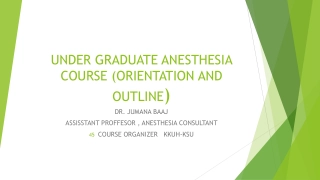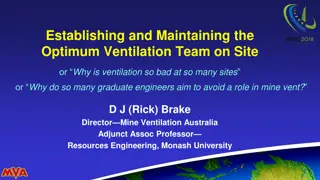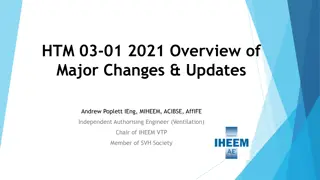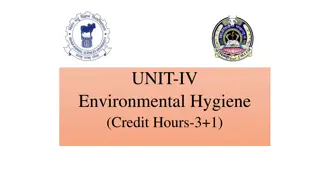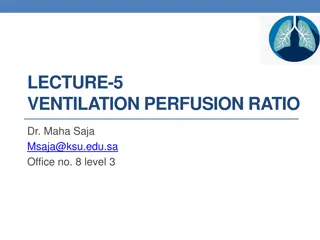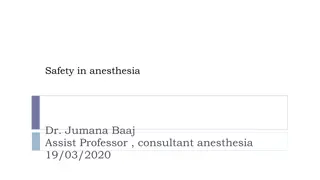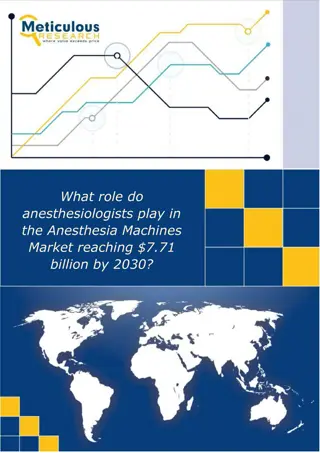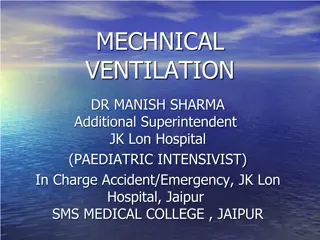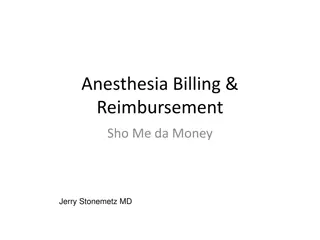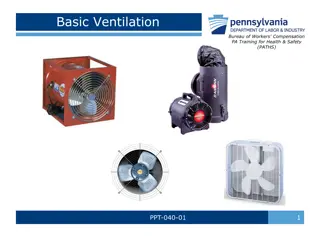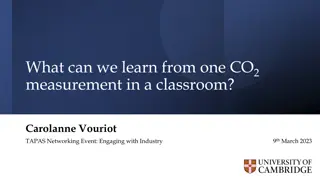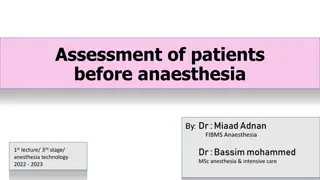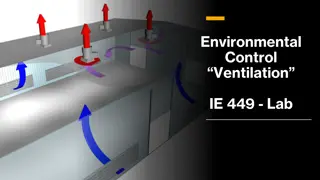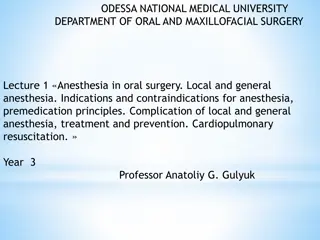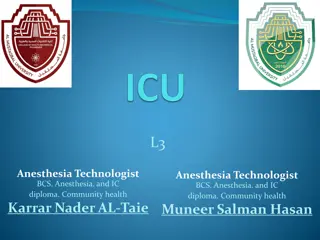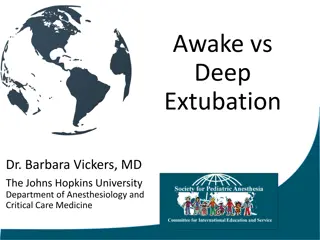Mechanical Ventilation in Anesthesia Practice
Anesthesia technologists play a crucial role in managing artificial ventilation, including concepts like Invasive Positive Mechanical Ventilation (IPMV), Fraction of Inspired Oxygen (FIO2), Tidal Volume (VT), Peak Flow Rate, Respiratory Rate, Minute Volume (VE), I:E Ratio, and more. They monitor and adjust parameters to support patients' respiratory needs effectively during procedures. This comprehensive guide covers key aspects of mechanical ventilation in anesthesia practice.
Download Presentation

Please find below an Image/Link to download the presentation.
The content on the website is provided AS IS for your information and personal use only. It may not be sold, licensed, or shared on other websites without obtaining consent from the author.If you encounter any issues during the download, it is possible that the publisher has removed the file from their server.
You are allowed to download the files provided on this website for personal or commercial use, subject to the condition that they are used lawfully. All files are the property of their respective owners.
The content on the website is provided AS IS for your information and personal use only. It may not be sold, licensed, or shared on other websites without obtaining consent from the author.
E N D
Presentation Transcript
L3-2 Anesthesia Technologist BCS. Anesthesia. and IC diploma. Community health Karrar Nader AL-Taie Anesthesia Technologist BCS. Anesthesia. and IC diploma. Community health Muneer Salman Hasan
Artificial Ventilation Part 2
2-Invasive positive Mechanical Ventilation ((IPMV)) defined as the delivery of positive pressure to the lungs via an endotracheal or tracheostomy tube. During mechanical ventilation, a predetermined mixture of air (ie, oxygen and other gases) is forced into the central airways and then flows into the alveoli
1-Fraction of inspired oxygen (FIO2) 2-Tidal Volume (VT) 3-Peak Flow/ Flow Rate 4-Respiratory Rate/ Breath Rate / Frequency (F) 5-Minute Volume (VE) 6-I: E Ratio (Inspiration to Expiration Ratio) 7-Sigh 8-peak inspiratory pressure (PIP) 9-Inspirtory Time Ti 10- trigger
1-Fraction of inspired oxygen (FIO2) The percent of oxygen concentration that the patient is receiving from the ventilator. (Between 21% & 100%) Initially a patient is placed on a high level of FIO2 (60% or higher) 2-Tidal Volume (VT) The volume of air delivered to a patient during a ventilator breath. amount of air inspired and expired with each breath. Usual volume selected is between 6 to 8 ml/ kg the large tidal volumes may lead to (volutrauma) aggravate the damage inflicted on the lungs
3-Peak Flow/ Flow Rate The speed of delivering air per unit of time, and is expressed in liters per minute. The higher the flow rate, the faster peak airway pressure is reached and the shorter the inspiration The lower the flow rate, the longer the inspiration 4-Respiratory Rate/ Breath Rate / Frequency (F) The number of breaths the ventilator will deliver/minute (10-16 b/m). Total respiratory rate equals patient rate plus ventilator rate.
5-Minute Volume (VE) The volume of expired air in one minute. Respiratory rate times tidal volume equals minute ventilation VE = (VT x F) In special cases, hypoventilation or hyperventilation is desired 6-I: E Ratio (Inspiration to Expiration Ratio) The ratio of inspiratory time to expiratory time during a breath (Usually = 1:2) 7-Sigh A deep breath. A breath that has a greater volume than the tidal volume. It provides hyperinflation and prevents atelectasis. Sigh volume:Usual volume is 1.5 2 times tidal volume. Sigh rate/ frequency :Usual rate is 4 to 8 times an hour
8-peak inspiratory pressure (PIP) The amount of pressure that need to enter the gas into the lung , the risk of barotrauma is increased and efforts should be made to try to reduce the peak airway pressure. 9-Inspirtory Time (Ti ) Time that need to end the inspiratory phase Normal renge = 0.33__ 0.6 s 10- trigger If the machine start breath = control or time trigger If the patient start breath = patient trigger
Invasive positive Mechanical Ventilation ((IPMV)) The is three type of mode to ventilate patient in ICU 1-Volume cycle ventilators - Volume mode 2-Pressure cycle ventilators - Pressure mode 3-Time cycle ventilators Time mode
Volume cycle ventilators - Volume mode Volume is consistent with these modes, pressure is not. Inspiration is terminated after a preset tidal volume has been delivered by the ventilator. inspiration stops when the preset tidal volume is achieved. The amount of pressure required to deliver the set volume depends on: 1 - Patient s lung compliance 2- Patient ventilator resistance factors.
Volume mode 1- Assist-control (A/C) 2- Synchronized intermittent mandatory ventilation (SIMV) 3- Control Mode (CM) Continuous Mandatory Ventilation(CMV)
1-Assist-control (A/C) he ventilator provides the patient with a pre-set tidal volumeat a preset rate. The patient may initiate a breath on his own ventilator assists by delivering a specified tidal volume to the patient patient can breathe at a higher rate than the preset number of breaths/minute In A/C mode, a mandatory (or control ) rate is selected peak inspiratory pressure (PIP) must be monitored in volume modes because it varies from breath to breath. Disadvantages: Hyperventilation
-VT -RR -Flow Rate -I:E ratio -PEEP -FIO2 -peak inspiratory pressure (PIP)
Assist-control ventilation advantage 1-reduce the need for sedation and paralysis 2-decrease the risk of barotrauma 3- improve intrapulmonary gas distribution 4- prevent muscle atrophy
Assist-control ventilation disadvantage 1-The system is volume-cycled, and barotrauma is a concern in stiff lungs. ... 2-If a patient is tachypneicor if not enough time is allowed for exhaling, the patient can develop breath stacking and auto-PEEP. ... 3-Since the patient can initiate breaths, hyperventilation can lead to respiratory alkalosis.
2-Synchronized intermittent mandatory ventilation (SIMV) pre-set number of breaths/minute at a specified tidal volume and FiO2. the patient is able to breathe spontaneously the tidal volume is determined by the patient s spontaneous effort. Adding pressure support during spontaneous breaths can minimize the risk of increased work of breathing. Ventilators breaths are synchronized with the patient spontaneous breath. (no fighting) Used to wean the patient from the mechanical ventilator
-VT -RR -PEEP I:E - Ti Flow rate FiO2
SIMV advantages 1-enables partial mechanical assistance 2-provide a set number of breaths at a fixed tidal volume, 3- 3-patient can trigger a spontaneous breath with the volume determined by patient effort SIMV Disadvantages - higher level of work the patient must perform to obtain a spontaneous breath.
3-Continuous Mandatory Ventilation(CMV) Volume-controlled ventilation (VCV) Ventilation is completelyprovided by the mechanical ventilator with a preset tidal volume, respiratory rate and oxygen concentration Ventilator totally controls the patient s ventilation Patient does not breathe spontaneously. cannot initiate breath
-VT -RR Flow rate I:E - Ti PEEP FiO2
Advantages of VCV: Guaranteed tidal volumes produces a more stable minute volume Disadvantages of VCV airway pressure increases in response to reduced compliance, increased resistance,


